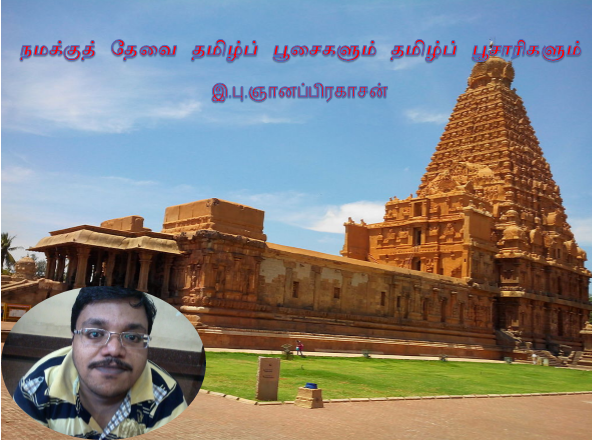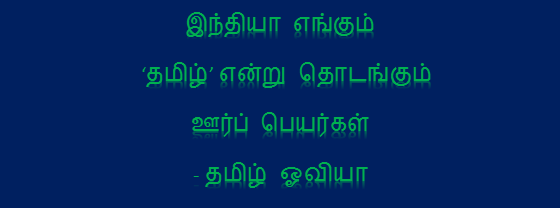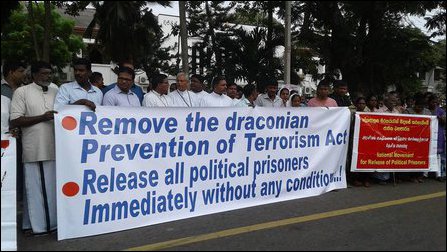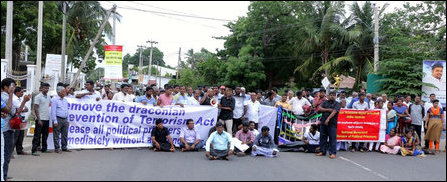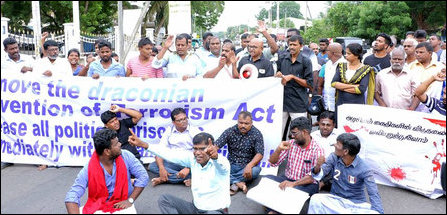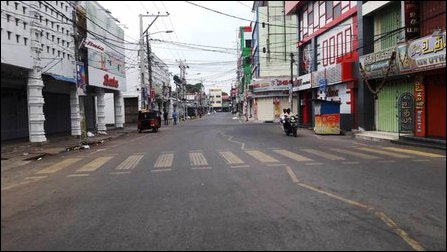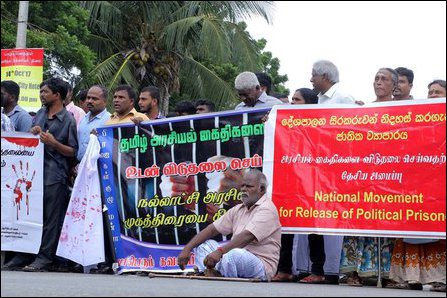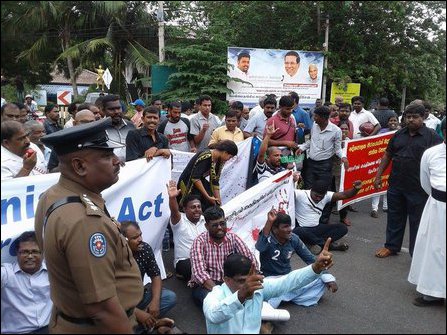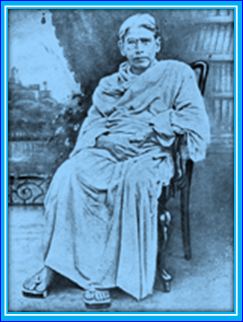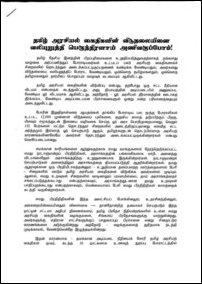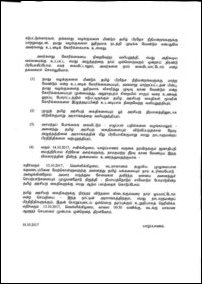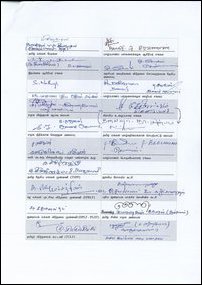நமக்குத் தேவை தமிழ்ப் பூசைகளும் தமிழ்ப் பூசாரிகளும்~1/3
கடவுளை நம்ப உலகில் உள்ள எல்லோருக்கும் உரிமை இருக்கும்பொழுது, அந்தக் கடவுளைப் பூசை செய்யவும் நம்புகிற எல்லோருக்கும் உரிமை இருப்பதுதானே முறை? ஆனால், இங்கு நடப்பது என்ன?…
கடவுள் மீது அன்பு(பக்தி) செலுத்த எல்லாரும் வேண்டும்; அந்தக் கடவுளுக்குக் கோயில் கட்ட எல்லா சாதியினரும் வேண்டும்; உண்டியலில் காசு போட எல்லாத் தரப்பு மக்களும் வேண்டும்; ஆனால், கடவுளின் அறைக்குள் (கருவறை = அகநாழிகை) செல்லவும் தொட்டுப் பூசை செய்யவும் மட்டும் குறிப்பிட்ட சிலருக்குத்தான் உரிமை! மனச்சான்றுள்ள மனிதர் யாராவது இதை ஏற்க முடியுமா? ஆனால், தமிழ்நாட்டின் பெரும்பாலான மக்கள் இதை மனமுவந்து ஏற்றுக் கொண்டுதான் வாழ்ந்து – வழிபட்டு வருகிறார்கள். ஆம்! பிராமணரல்லாதாருக்கும் பூசை செய்யும் உரிமை வேண்டும் என்கிற கோரிக்கை பிராமணரல்லாதவர்களிலேயே பெரும்பான்மை மக்களுக்கு அவ்வளவாகப் பிடிக்கவில்லை என்பதே உண்மை. “கோயில் பூசாரி போன்ற புனிதமான வேலைகளில் பிராமணர்கள் இருப்பதே சரி” என்பதுதான் இங்குள்ள பெரும்பான்மை மக்களின் கருத்து.
இது சரியா? தமிழர்கள் கடவுளைப் பூசிக்கக்கூடாதா? அப்படிப் பூசிப்பது சமய நம்பிக்கைகளுக்கோ வேறு ஏதேனும் நெறிமுறைகளுக்கோ எதிரானதா? அலசிப் பார்ப்போம் வாருங்கள்!
ஆகமங்கள் கூறுவது என்ன?
“பிராமணர்கள்தாம் கோயில் பூசாரிகளாக இருக்க வேண்டும்! மற்றவர்கள் அப்பணிக்கு வரக்கூடாது” எனக் கடுமையாக எதிர்ப்பவர்கள் அதற்குச் சான்றாகக் கைகாட்டுவது ஆகமங்களை. அப்படியானால், வடநாட்டில் மட்டும் மக்கள் நேரடியாக அகநாழிகைக்குள் போய்க் கடவுளைத் தங்கள் கைகளாலேயே தொட்டுப் பூசை செய்கிறார்களேஎனக் கேட்டால், ஆகமங்கள் தென்னாட்டினருக்கு மட்டும்தான் எனக் கூசாமல் புளுகுகிறார்கள். ஆனால், ஆகமங்களில் அப்படி எங்கேயும் குறிப்பிடப்படவில்லை என்பதே உண்மை.
கோயில் கட்டும் முறைகள், கோயில்களின் வழிபாட்டு முறைகள் முதலான அனைத்துக்கும் வழிகாட்டியாக இருப்பவை ஆகமங்கள். ஆனால், அவற்றில் எங்குமே இன்ன சாதியினர்தாம் பூசை செய்ய வேண்டும் எனக் குறிப்பிடப்படவில்லை எனப் பலரும் உறுதிப்படுத்தியுள்ளனர்.
ஆகமங்களையும் கோயில்களையும்பற்றி ஆராய்ந்து ‘கோயில்கள் ஆகமங்கள் மாற்றங்கள்’ எனும் நூலை எழுதியிருக்கும் நீதியாளர் ஏ.கே.இராசன் அவர்கள் “ஆகமங்கள் எவற்றிலும் ஒரு குறிப்பிட்ட சாதியைச் சேர்ந்தவர்கள்தான் பூசை செய்ய வேண்டும் என்று எந்த இடத்திலும் சொல்லப்படவில்லை” என்று அந்நூலில் தெளிவாகக் கூறியுள்ளார்.
“ஒரு கோவிலில் ஒருவர் அருச்சகராக அல்லது பூசாரியாக வருவதற்குள்ள ஒரே சோதனை தீட்சை மட்டுமேயன்றி சாதியோ, வகுப்போ அல்ல” என ‘ஆலயப்பிரவேச உரிமை’, பக்க எண்: 75-இல் திட்டவட்டமாகக் கூறப்பட்டுள்ளது. கோபால(மூப்பனா)ர் வழக்கில், “கோயில் அகநாழிகைக்குள் ஆகமம் ஒப்புதலளிக்காத நிலையில் பிராமணர்கள் கூட நுழையக் கூடாது” என்று சென்னை உயர்நீதிமன்றம் தீர்ப்புரைத்திருப்பதும், ‘அனைத்து சாதியினரும் பூசாரியாகலாம் (அர்ச்சகராகலாம்)’ என்ற தமிழ்நாடு அரசுச் சட்டத்துக்கு எதிரான வழக்கின் தீர்ப்பில் சென்னை உயர்நீதிமன்றத்தின் மேற்படி தீர்ப்பை உச்சநீதிமன்றமும் சுட்டிக்காட்டியிருப்பதும் இக்கருத்தை ஐயம் திரிபற உறுதிப்படுத்துகின்றன.
உண்மை இவ்வாறிருக்க, பிராமணர்கள் தவிர வேறு யாரும் கோயில் அகநாழிகைக்குள் நுழையக்கூடாது, கடவுளைத் தொட்டுப் பூசை செய்யக்கூடாது என ஆகமம் கூறுவதாகத் திரும்பத் திரும்பச் சொல்லி வருவது எப்பேர்ப்பட்ட பொய் என்பதையும், இதை எதிர்த்துக் கேள்வி கேட்பவர்களை “வேண்டுமானால், நீங்கள் சொந்தமாக ஒரு கோயில் கட்டி, உங்கள் விருப்பப்படி யாரை வேண்டுமானாலும் பூசாரியாக வைத்துக் கொள்ளுங்கள்” எனச் சிலர் நக்கலடிப்பது எவ்வளவு இழிவான சாதியத் திமிர் என்பதையும் மக்கள் சிந்திக்க வேண்டும்!
அடுத்தது மரபு!
கோயில் பூசை குறித்துத் தமிழ்நாட்டு மரபு சொல்வது என்ன?
முதலில் மரபு என்பது என்ன? வெகு காலமாகத் தொடர்ந்து பின்பற்றப்படும் வழக்கத்தையே மரபு என்கிறோம். கி.பி 8ஆம் நூற்றாண்டிலிருந்துதான் பிராமணர்கள் கோயிலில் பூசை செய்யத் தொடங்கினார்கள் என்கிறது வரலாறு. (‘இந்தியாவில் மட்டும் சாதி இருப்பது ஏன்?’ – வே.கன்னுப்பிள்ளை இ.ஆ.ப). ஆனால், தமிழர் வரலாறோ கி.மு 1000-இலிருந்து தொடங்குகிறது. ஆக, கிறித்து பிறக்கும் முன் ஆயிரம் ஆண்டுகள், கிறித்து பிறந்த பின் 800 ஆண்டுகள் (கி.பி 8ஆம் நூற்றாண்டு) என 1800 ஆண்டுகளாகத் தமிழ்நாட்டில் பிராமணரல்லாதவர்கள்தாம் – தமிழர்கள்தாம் எல்லாக் கோயில்களிலும் பூசாரிகளாக இருந்திருக்கிறார்கள் என்பதும், கி.பி 8ஆம் நூற்றாண்டு முதல் தற்பொழுதைய 21ஆம் நூற்றாண்டு வரை 1300 ஆண்டுகளாகத்தான் பிராமணர்கள் கோயில் பூசைகளைச் செய்து வருகிறார்கள் என்பதும் தெரிய வருகிறது. ஆகவே, பிராமணரல்லாத தமிழர்களைப் பூசாரிகளாகப் பணியமர்த்துவது மரபுப்படி சரியானதே என்பதில் ஐயமே தேவையில்லை.
ஒருவேளை, மரபு என்பது எத்தனை ஆண்டுக்காலமாக ஒரு வழக்கம் பின்பற்றப்படுகிறது என்பதைப் பொறுத்ததில்லை; குறிப்பிட்ட குமுகாயத்தின் (சமுதாயத்தின்) தொன்மையான வழக்கம் அல்லது நாகரிகம் எதுவோ அதுவே மரபு எனச் சிலர் கூறலாம். அப்படி வைத்துக் கொண்டாலும், தொன்மைப் பழங்காலத்தில் பிராமணர்கள் தமிழ்நாட்டுக் கோயில்களில் பூசாரிகளாக இல்லை; தமிழர்கள்தாம் அவ்வாறு இருந்திருக்கிறார்கள் என்பதால், அவ்வகையிலும் பிராமணரல்லாத தமிழர்களைப் பூசாரிகளாகப் பணியமர்த்துவது மரபுப்படி சரியானதே என்பது உள்ளங்கை நெல்லிக்கனி.
ஒருக்கால், கோயில்களின் ‘சம்பிரதாயம்’ இதற்கு எதிராக இருக்குமோ எனப் பார்த்தால் அதுவும் இல்லை. காரணம், வழிவழியாகக் கடைப்பிடிக்கப்படும் வழக்கம்தான் ‘சம்பிரதாயம்’ எனப்படுகிறது. அப்படிப் பார்த்தால், தொடக்கத்திலிருந்து பல்லாண்டுகளாகக் கடைப்பிடிக்கப்பட்டு வந்த தமிழ்ப் பூசாரிகளைக் கோயில்களில் பணியமர்த்தும் வழக்கம் இடையில் முறிக்கப்பட்டுத்தான் இன்றைய வழக்கம் – அதாவது, பிராமணர்கள் மட்டுமே பூசாரிகளாக இருக்கும் வழக்கம் – திணிக்கப்பட்டுள்ளது என்பதால், ‘சம்பிரதாயம்’ என்கிற அடிப்படையில் பார்த்தாலும் தமிழர்கள் பூசாரிகளாக அமர்வது சரியெனவே ஆகிறது.
சட்டம் என்ன சொல்கிறது?
தமிழர்களின் பூசை உரிமையை நிலைநாட்ட 2006ஆம் ஆண்டு தமிழ்நாடு அரசு ‘அனைத்துச் சாதியினரும் பூசாரியாகலாம்’ என்று சட்டம் இயற்றியது. இதை எதிர்த்து, மதுரை ஆதி சைவ சிவாச்சாரியார்கள் நலச் சங்கத்தினரும் பிறரும் உச்சநீதிமன்றத்தில் தொடுத்த வழக்கில் சிவாச்சாரியர்கள் முதலானோரின் விண்ணப்பத்தை (மனுவை)த் தள்ளுபடி செய்த உச்சநீதிமன்றம், அதே நேரத்தில் “ஆகம நெறி, சம்பிரதாயம், மரபு ஆகியவற்றுக்கு இணங்கவே பூசாரிகள் பணியமர்த்தப்பட வேண்டும்” என்றும் குறிப்பிட்டுள்ளது. ஆனாலும், தமிழ்நாட்டு அரசின் சட்டத்தைத் தள்ளுபடி செய்யாமல், அதை எதிர்த்து வழக்குத் தொடுத்தவர்களின் தரப்பையே உச்சநீதிமன்றம் புறந்தள்ளி இருப்பதால், குறிப்பிட்ட கட்டுப்பாட்டுக்கு(நிபந்தனைக்கு) உட்பட்டுத் தமிழ்நாட்டு அரசு பிராமணர் அல்லாத தமிழர்களையும் பூசாரிகளாக்க நடவடிக்கை எடுக்கலாம் என இதன் மூலம் சட்டப்படி வழி வகுக்கப்பட்டுள்ளது. தவிர, தீர்ப்பில் குறிப்பிடப்பட்டுள்ள கட்டுப்பாட்டின்படி பார்த்தாலும் தமிழ்ப் பூசாரிகளைப் பணியமர்த்துவதில் எந்தத் தடையும் இல்லை; ஆகமமோ மரபோ சம்பிரதாயமோ தமிழர்களைப் பூசாரிகளாக்க எவ்விதத்திலும் குறுக்கே நிற்கவில்லை என்பதையும் பார்த்தோம்.
இதே போல, 2002ஆம் ஆண்டு, கேரளாவில் ஈழவ வகுப்பைச் சேர்ந்த இராசேசு என்பவரை அம்மாநில தேவசம் வாரியம் பூசாரியாகப் பணியமர்த்தியபொழுதும், அதை எதிர்த்து உச்சநீதிமன்றத்தில் தொடுக்கப்பட்ட வழக்கில், “சாதிப் பாகுபாடுகளை நிலைநிறுத்தும் எந்த வழிபாட்டு முறையையும் ஏற்க முடியாது” என்று கூறி இராசேசின் பணியமர்த்தலை உச்சநீதிமன்றம் உறுதி செய்தது இங்கு குறிப்பிடத்தக்கது.
ஆகச், சட்டப்படி பார்த்தாலும் தமிழர்கள் பூசாரிகளாவதில் எந்தத் தவறும் இல்லை என்பதே உண்மை!
கடவுளுக்கு அடுக்குமா?
பிராமணர் அல்லாதோர் கடவுளைத் தீண்டுவதையோ பூசை செய்வதையோ கடவுள் ஏற்க மாட்டார், விரும்ப மாட்டார் எனப் பலரும் கருதுகின்றனர். அப்படி நினைப்பவர்கள் கண்ணப்ப நாயனார் கதையைச் சிந்தித்துப் பார்க்க வேண்டும்!
பிராமணர் அல்லாதவரும் சாதியால் தாழ்த்தப்பட்டவருமான கண்ணப்பர் செய்த பூசையைச் சிவபெருமான் ஏற்கவில்லையா? இத்தனைக்கும் கண்ணப்பர் எப்படி அந்தப் பூசையைச் செய்தார்? இன்று நீதிமன்றங்களும் பழமையாளர்களும் மாய்ந்து மாய்ந்து வலியுறுத்தும் ஆகம நெறிகளின்படியா? இல்லை!
இறைவனுக்குச் சாற்றுவதற்கான மலர்களைத் தன் தலையில் செருகிக் கொண்டு, திருமுழுக்குக்கான(அபிசேகம்) நீரைத் தன் வாயில் நிரப்பிக் கொண்டு, படையலுக்குப் பன்றிக் கறியை – அதுவும், சுவையான கறித் துண்டங்கள் எவை என்று மென்று பார்த்துச் சேகரித்து – எடுத்துக் கொண்டு போய் இவற்றை வைத்துத்தான் சிவலிங்கத்துக்குப் பூசை செய்தார் கண்ணப்பர்! இந்தப் பூசையைத் தனக்கு உவப்பானது என்று இறைவனே அந்தக் கோயிலுடைய பட்டரின் கனவில் வந்து உரைத்ததாக, நான் சொல்லவில்லை; பிராமணர்கள் – பிராமணர் அல்லாதோர் ஆகிய இரு தரப்பினரும் புனித நூலாகப் போற்றும் பெரிய புராணம் கூறுகிறது.
சிவன் மட்டுமில்லை, இன்ன பிற தெய்வங்களும் கூட சாதியை ஒரு பொருட்டாகக் கருதுவதில்லை என்பதற்கு இப்படி எத்தனையோ எடுத்துக்காட்டுகளைப் புராண – இதிகாச – வரலாற்று நூல்களிலிருந்தே சுட்டிக்காட்ட முடியும்.
தீண்டத்தகாத குலம் என்று குறிக்கப்பட்ட பாணர் குலத்தைச் சேர்ந்தவரான திருப்பாணாழ்வாரைப் பெருமாள் கோயில் பட்டர் கல்லால் அடித்தபொழுது அவர் மீது பட்ட காயத்தால் தன் மேனியில் குருதி வடிவதாகவும், திருப்பாணாழ்வாரும் தானும் வேறு வேறு இல்லை என்றும் திருமால் ஒருமுறை திருவிளையாடல் நிகழ்த்திக் காட்டியதாக ஆழ்வார்கள் வரலாறு கூறுகிறது.
இன்று தாழ்த்தப்பட்டவராகக் கற்பிக்கப்படும் மலைவாழ் மகளான வள்ளியை முருகன் தேடி வந்து காதலித்து மணம் புரிந்ததாகக் கந்த புராணம் காட்டுகிறது.
என்னதான் இறையியலில் கரை கண்டிருந்தும் ஆதிசங்கரருக்கு சாதி வேறுபாடு பார்க்கும் குணம் போகாததால் இறைவன் தானே சண்டாள வடிவில் வந்து அறிவு புகட்டி அவரை அடிபணியச் செய்ததாக ஆதிசங்கரரின் வாழ்க்கை வரலாறு பதிவு செய்துள்ளது.
அம்மன்களைப் பொறுத்த வரை கேட்வே வேண்டா! அன்று முதல் இன்று வரை எத்தனையோ அம்மன் கோயில்களில் தமிழர்கள்தாம் பூசாரிகளாக இருந்திருக்கிறார்கள், இருக்கிறார்கள். இப்படி எத்தனையோ சான்றுகளை அடுக்கிக் கொண்டே போகலாம்.
இப்படி, தன்னை நெருங்கவும், தன்னோடு இரண்டறக் கலக்கவும் கூட சாதியோ பிறப்போ தொழிலோ இது போன்ற வேறு எதுவுமோ ஒருநாளும் பொருட்டில்லை; தன் மீதான உண்மை அன்பு ஒன்றே அதற்கான தகுதி என்று வெவ்வேறு காலக்கட்டங்களில் கடவுள் மீண்டும் மீண்டும் பலமுறை உணர்த்தியும் கடவுளைத் தொட்டுப் பூசை செய்ய சாதியை ஒரு தடையாக நினைப்பது எந்தளவுக்குக் கடவுளுக்கு எதிரான நிலைப்பாடு என்பதைக் கடவுள் நம்பிக்கையாளர்கள் முதலில் உணர வேண்டும்!
“தமிழர்களின் பூசை உரிமை பற்றி இவ்வளவு பேசுகிறீர்களே, தமிழர்களுக்கெனப் பூசை முறைகள் உண்டா? தனிப்பட்ட இறைக் கொள்கை உண்டா?” எனச் சிலர் கேட்கலாம். அதற்கான விடைகள் அடுத்த பகுதியில்.
– தொடரும்
– இ.பு.ஞானப்பிரகாசன்
[‘அனைத்துச் சாதியினரும் பூசாரியாகலாம்’ என அண்மையில் கேரள அரசு சட்டம் இயற்றியிருப்பதைப் பாராட்டுகிறோம். தமிழ்க் காப்புக் கழகத்தால் நடத்தப்பட்ட ‘நமக்குத் தேவை தமிழ்ப் பூசைகளும் தமிழ்ப் பூசாரிகளும்’ எனும் கட்டுரைப் போட்டியில் இலக்குவனார் இலக்கிய இணையம் சார்பில் தை 16 , 2047 / சனவரி 30 , 201 இல் வள்ளல் மாம்பலம் ஆ.சந்திரசேகர் அவர்களால் உரூ.3000/- பரிசில் வழங்கிப் பாராட்டப்பெற்ற திரு இ.பு.ஞானப்பிரகாசன் கட்டுரையை இந்த நேரத்தில், வெளியிடுகிறோம்.]
